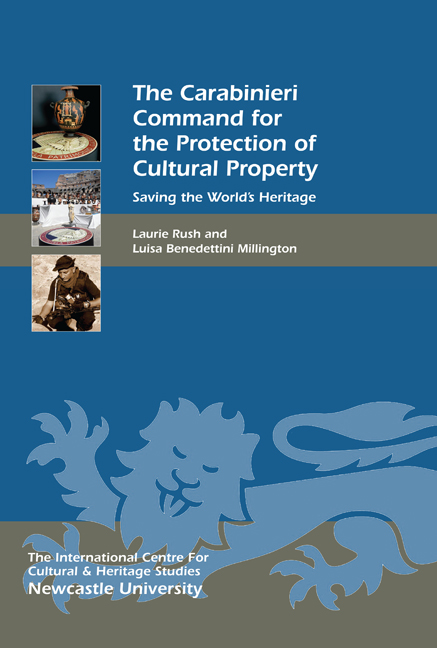Book contents
- Frontmatter
- Contents
- List of Illustrations
- Acknowledgments
- Foreword (in English and in Italian): Brigadier General Mariano Mossa
- Prefazione
- Abbreviations
- 1 The Carabinieri TPC: an Introduction and Brief History. Perché l’Italia? Why Italy?
- 2 Headquarters, the Databank and Operative Department in Rome
- 3 Carabinieri Public Outreach and Education
- 4 Central Italy and the Adriatic: Lazio, Florence, Bologna and Ancona
- 5 Activities in the North: Genova, Monza, Torino and Venezia
- 6 The Regional Offices: Naples, Bari and the South
- 7 The Challenges of the Island Regions: Sicily, Sardinia and the Palermo, Siracusa and Sassari Nuclei
- 8 Investigation Techniques
- 9 Repatriation of Works of Art to Italy: From Siviero to the Medici Conspiracy
- 10 Fakes, Forgeries and Money Laundering
- 11 Who Are the Officers of the Carabinieri TPC?
- 12 The Carabinieri, Peacekeeping and Foreign Relations: The Carabinieri Mission to Iraq
- 13 ‘The Italian Model’
- Bibliography and References
- About the Authors
- Index
- Heritage Matters
7 - The Challenges of the Island Regions: Sicily, Sardinia and the Palermo, Siracusa and Sassari Nuclei
Published online by Cambridge University Press: 21 May 2021
- Frontmatter
- Contents
- List of Illustrations
- Acknowledgments
- Foreword (in English and in Italian): Brigadier General Mariano Mossa
- Prefazione
- Abbreviations
- 1 The Carabinieri TPC: an Introduction and Brief History. Perché l’Italia? Why Italy?
- 2 Headquarters, the Databank and Operative Department in Rome
- 3 Carabinieri Public Outreach and Education
- 4 Central Italy and the Adriatic: Lazio, Florence, Bologna and Ancona
- 5 Activities in the North: Genova, Monza, Torino and Venezia
- 6 The Regional Offices: Naples, Bari and the South
- 7 The Challenges of the Island Regions: Sicily, Sardinia and the Palermo, Siracusa and Sassari Nuclei
- 8 Investigation Techniques
- 9 Repatriation of Works of Art to Italy: From Siviero to the Medici Conspiracy
- 10 Fakes, Forgeries and Money Laundering
- 11 Who Are the Officers of the Carabinieri TPC?
- 12 The Carabinieri, Peacekeeping and Foreign Relations: The Carabinieri Mission to Iraq
- 13 ‘The Italian Model’
- Bibliography and References
- About the Authors
- Index
- Heritage Matters
Summary
The Italian region of Sicily has an extraordinary history. Prior to Italian unification, this island, located off the ‘toe’ of the ‘boot’, was settled and colonised by many different early civilisations of the Mediterranean area, each leaving behind important urban remains including temples, palaces, castles, mosques and amphitheatres. The Greeks, Carthaginians, Phoenicians, Romans and Arabs all conquered Sicily, leaving traces of their majestic empires. The cultural property of Sicily also offers an historical context for today's society to gain an understanding of how it is possible for people of different cultures to travel from great distances, live together in an island setting and enrich each other's lives.
The then Captain (now Major) of the Palermo and Siracusa units, Giuseppe Marseglia, emphasised the significance of the multicultural dimensions of the cultural property for which he is responsible as he introduced the author (Rush) to the Island of Sicily and its cultural wealth (Marseglia 2011, pers comm ). He made sure that the tour included the Palatine Chapel – the chapel of the Norman Kings of Sicily – located on the second floor of the Palazzo Reale in Palermo (see Fig 7.1). Beginning with the 12th-century Byzantine apses and mosaics, the architectural elements of the chapel are artistic masterpieces produced by the very best artists and craftsmen the diverse communities of Palermo had to offer. The transept mosaics illustrate the Acts of the Apostles, are narrated with Arabic inscriptions and are framed in a style reminiscent of Eastern icons. Even more remarkable, the Byzantine images are placed within a structure defined by Arabic arches and the Byzantine dome also features Arabic inscriptions.
The ceiling of the chapel is a Muqarnas ceiling composed of detailed geometric inlay, reminiscent of Abbasid designs found in places such as Baghdad, Iraq. The mosaics located outside of the transept, more secular in nature, feature Latin inscriptions and are clearly the work of yet another group of artisans. Perhaps the most powerful symbol of the shared cultural elements and artistry is the Christian cross in the ceiling, formed in part by a pattern of Islamic eight-pointed stars. The juxtaposition of contrasting styles, language and great beauty add spiritual power to this extraordinary sacred place.
- Type
- Chapter
- Information
- The Carabinieri Command for the Protection of Cultural PropertySaving the World's Heritage, pp. 95 - 110Publisher: Boydell & BrewerPrint publication year: 2015



